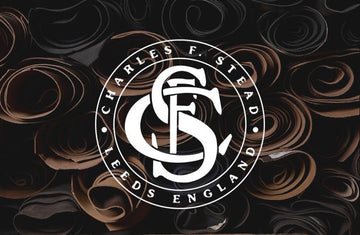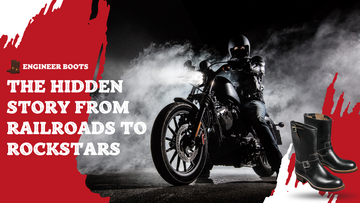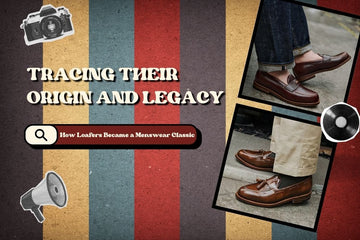In the realm of high-end footwear, the material quality defines both comfort and craftsmanship. Among the elite names in premium suede production, Charles F. Stead & Co. Ltd. has earned global recognition for its unmatched expertise and heritage. As a historic British tannery with over a hundred years of tradition, C.F. Stead has set the benchmark for fine suede leathers that blend durability with elegance. This article takes a closer look at the legacy of C.F. Stead, explores their signature tanning techniques, and showcases how their luxurious leathers elevate timeless classics like suede Chelsea boots and rugged men’s work boots.
A Storied History: The Genesis and Growth of C.F. Stead
Laying the Foundation: From Apprentice to Innovator (1890–1910)
The story of C.F. Stead begins in the late 19th century, when a young Charles F. Stead entered the leather trade as an apprentice at Thomas Wright & Co. Ltd. These formative years helped him build a deep understanding of leather craftsmanship and customer engagement. Recognizing emerging opportunities within the industry, Stead made a bold move in the early 1900s by acquiring the historic Sheepscar Tannery in Leeds, a site with roots dating back to 1823. This pivotal step marked the start of his independent venture, where he began producing high-quality leathers from British sheepskins. The tannery initially specialized in products such as bookbinding leather, chamois, and finely crafted “fancy” leathers used in small goods like wallets and purses, laying the groundwork for the brand’s future in luxury suede production.

Industrial Advancements and Suede’s Rise to Fame (1910–1940)
The early 20th century brought transformative changes to leather manufacturing, with the introduction of steam-powered machinery reshaping traditional tanning techniques. During this era, C.F. Stead fully embraced modernization, streamlining production while maintaining exceptional material standards. The 1920s ushered in a golden age for suede footwear, spurred by influential tastemakers such as the Duke of Windsor. Amidst global instability during World War II, the company showcased its resilience by pivoting operations to support the Royal Air Force, crafting durable suede accessories and garments for military use—a testament to its ability to combine function with fine craftsmanship.
Post-War Expansion and International Acclaim (1940–1980)
After the war, C.F. Stead entered a new era of growth, broadening its product lines to include leather gloves, outerwear, and more refined fashion goods. The swinging 60s saw a creative leap with the introduction of vibrantly dyed suede, aligning the brand with the bold aesthetics of the time. By the 1980s, the tannery’s dedication to excellence culminated in receiving the Queen’s Award for Export Achievement, a prestigious recognition that affirmed Stead’s status as a global authority in premium leather craftsmanship.
Sustainable Craftsmanship for the Modern Era (1990–Present)
From the 1990s onward, C.F. Stead has been at the forefront of ethical leather production, integrating eco-conscious practices into its core. One standout initiative involves working closely with African communities to source sustainably harvested antelope hides, ensuring that both environmental impact and social responsibility are addressed. Today, the company’s luxury suedes are trusted by top-tier designers and artisan bootmakers, playing a vital role in shaping contemporary styles like Men’s Work Boots and Suede Chelsea Boots.

Mastering the Craft: The Distinctive Tanning Techniques of C.F. Stead
At the heart of C.F. Stead's legacy lies an artisanal tanning method that sets their luxury suede leather apart in both texture and performance. What distinguishes their approach is a specialized re-tanning technique designed to produce a tight, dense fiber structure. This method not only enhances the suede’s color depth and wear resistance but also gives it a refined softness rarely matched in the industry.
Advantages of C.F. Stead’s High-Quality Leather Tanning
Exceptional Longevity
By minimizing fat content during the re-tanning phase, the fibers are compacted more tightly—creating a suede that resists wear and deformation. This strength is essential in crafting durable men's boots like suede Chelsea boots or rugged workwear styles that are built to endure 10 to 15 years of regular use.
Low Maintenance Requirements
Thanks to its compact structure, C.F. Stead suede naturally resists dirt penetration, making it less prone to staining and far easier to clean. For wearers who value both elegance and practicality, this easy-care feature adds considerable appeal.
Rich Patina Over Time
Unlike lower-grade suede, which can fade or weaken, C.F. Stead’s materials develop a unique patina that deepens with age. This evolving surface texture adds character to the boots or shoes—telling a story through every crease and mark, and affirming the notion that quality leather gets better with time.
For more details on their tanning process, visit the Charles F. Stead Official Website.

Trusted by Icons: The Global Prestige of C.F. Stead’s Clientele
C.F. Stead’s legacy as a premium suede supplier is perhaps best reflected in the caliber of brands and shoemakers who choose to work with their materials. From elite fashion houses to heritage bootmakers, C.F. Stead’s reach spans continents and industries, cementing its reputation as a benchmark in high-end leather.
International Luxury Labels
Many of the world’s most recognized luxury fashion brands depend on C.F. Stead’s British-crafted suede to elevate their collections. These renowned houses turn to C.F. Stead for the exceptional texture, durability, and color richness of its leathers:
Their continued collaboration with C.F. Stead underlines the tannery’s unmatched consistency in delivering top-tier suede for luxury leather goods.
Leading Footwear Artisans Worldwide
Beyond high fashion, craft-focused footwear manufacturers across Europe, North America, and Asia choose C.F. Stead for their meticulous leatherworking standards:
In Europe:
-
John Lobb (established in 1849)
-
Edward Green (established in 1890)
-
Church’s (established in 1873)
-
Tricker’s (established in 1829)
-
Barker (established in 1880)
-
George Cleverley (established in 1898)
In North America:
-
Allen Edmonds (established in 1922)
-
Viberg (established in 1931)
-
White’s (established in 1902)
-
Alden (established in 1974)
-
Wesco (established in 1918)
-
Danner (established in 1932)
In Japan:
-
YUKETEN
-
Comme des Garçons
-
Julius
-
Neighborhood
-
Mastermind Japan
-
FOOT THE COACHER
The trust these high-end footwear manufacturers place in C.F. Stead speaks volumes. Whether for formal oxfords, rugged work boots, or avant-garde sneakers, the tannery’s suede continues to set a global standard for luxury and performance.
Why Opt for C.F. Stead Suede in Footwear Design?
When it comes to selecting premium materials for high-quality footwear, C.F. Stead suede stands out for its unparalleled performance, aesthetic appeal, and longevity. Here’s why discerning shoemakers and designers consistently choose it:
Exceptional Longevity
Engineered with a tightly woven fiber structure and minimal fat content, C.F. Stead suede offers outstanding durability. This robust composition makes it ideal for crafting long-lasting boots and shoes that can endure daily wear for over a decade.
Effortless Maintenance
Thanks to its dense surface texture, dirt and dust struggle to penetrate the suede, making cleaning and upkeep remarkably simple. For luxury footwear where visual appeal matters, this feature ensures your shoes retain their crisp, premium look over time.
Timeless Patina Development
Rather than wearing out, C.F. Stead’s suede matures with elegance, forming a rich patina that enhances the shoe’s uniqueness. Each pair evolves into a one-of-a-kind piece, telling a story through its textures and tones—an effect prized by collectors and style enthusiasts alike.

C.F. Stead’s Influence on Contemporary Footwear Design
The legacy of C.F. Stead's superior suede continues to inspire today’s footwear industry. Far from being limited to traditional styles, their premium leathers are now a key ingredient in modern shoe designs that seamlessly fuse heritage craftsmanship with innovative detailing.
Chelsea Boots: Iconic Elegance Reinvented
A cornerstone of men’s timeless footwear, Chelsea boots are revered for their clean silhouette and easy-to-wear design, marked by elastic side panels and ankle-high cuts. When these boots are made using C.F. Stead’s luxurious suedes, they achieve a rare blend of sophistication and resilience. Take, for instance, our Orion Chelsea Boots | C.F. Stead Repello Suede, Goodyear Welt—expertly constructed using Repello Suede and Janus Calf Suede. This design delivers rich texture and enduring strength. The Goodyear welt not only enhances longevity but also ensures flexibility and comfort, making them an ideal choice for both elevated looks and everyday style.

Explore the Suede Chelsea Boots for more details.
Men’s Work Boots: Where Strength Meets Sophistication
Modern men’s work boots are expected to deliver both dependable toughness and elevated style—and C.F. Stead’s Oil-Waxed Shoulder Leather rises to the occasion. Featured in our C.F. Stead Scout Boots | Vibram Sole, Goodyear Welt | Black Leather Work Boots, this premium leather showcases a rugged texture with a refined edge, making it ideal for boots designed to withstand demanding conditions without sacrificing visual appeal. Combined with a Vibram outsole for maximum grip and a Goodyear welt for long-lasting structure, these work boots strike the perfect harmony between hardwearing utility and contemporary urban design.

Learn more about our Mens Leather Work Boots | Scout Boots
Leading the Way in Sustainable Leather Practices
The global leather industry has experienced a significant shift toward sustainable and ethical production, and C.F. Stead stands as a leader in this evolution. By adopting eco-conscious tanning techniques and working closely with local communities for the responsible sourcing of antelope and deer hides, the tannery ensures that its operations uphold both environmental and ethical standards. This approach not only honors time-honored craftsmanship but also responds to the growing demand for environmentally friendly leather goods.
Today’s footwear designers increasingly prioritize sustainability in both material choice and production methods. Using C.F. Stead’s responsibly sourced leathers enables brands to create high-end shoes that don’t just perform and impress—but also align with modern eco-conscious values. In a market where sustainability influences purchasing decisions, this alignment offers brands a meaningful advantage.





